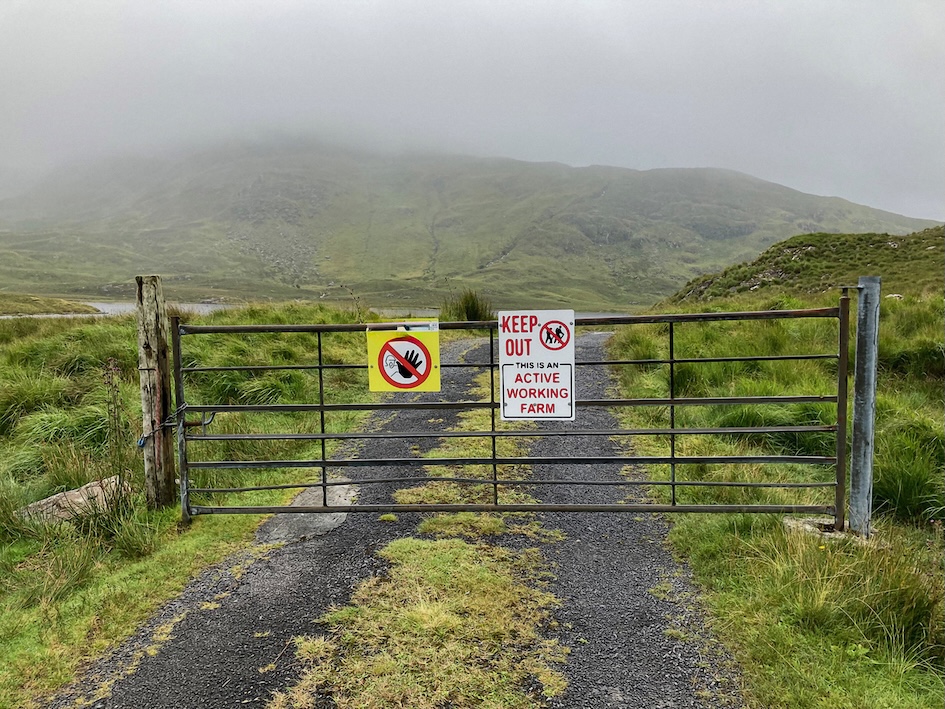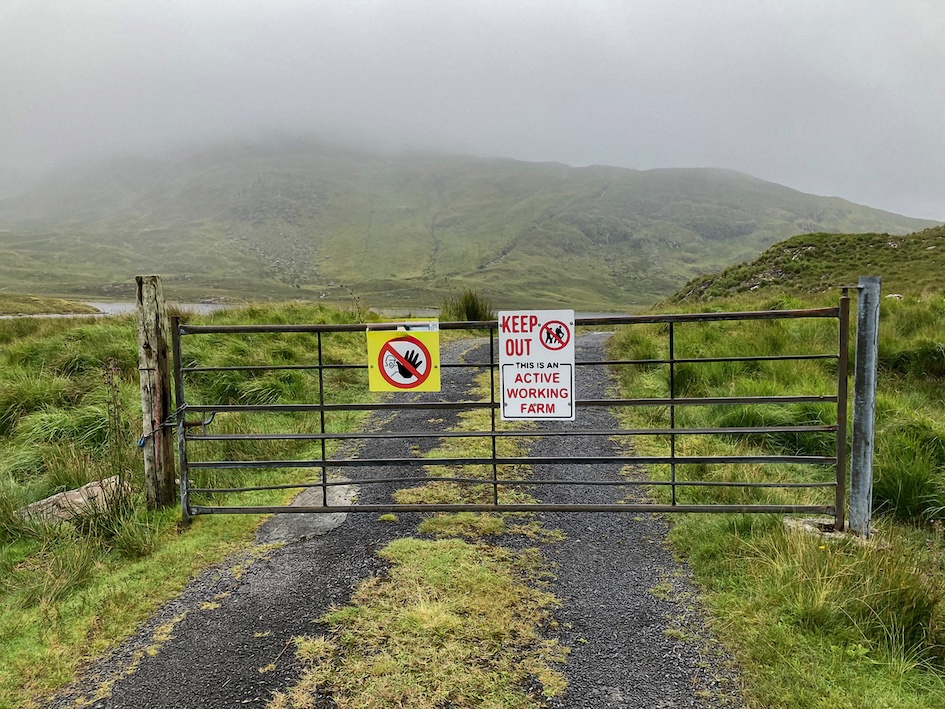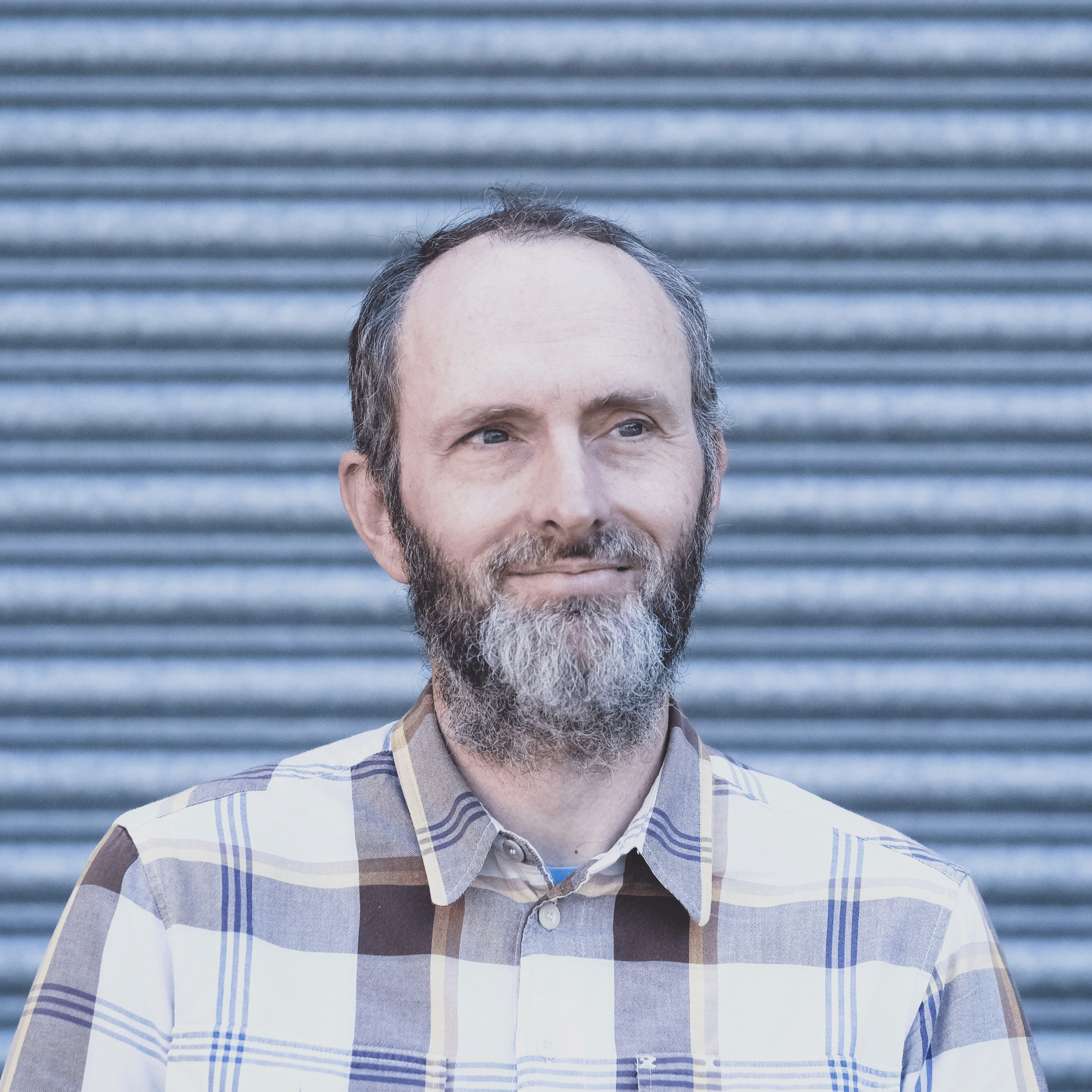Jonathan Stearn explains why and describes the uphill struggle to get some rights to head off road.

Words | Jonathan Stearn
Try to walk along the coast in Devlin near Louisburgh, Co. Mayo, and you’ll be confronted by barbed wire and signs warning you to keep out. Try the Cliffs of Moher in County Clare and you’ll find parts of the way barred, despite the public purse funding a coastal trail. Back in Mayo, you can climb Croagh Patrick, and benefit from the thousands of euros spent on the footpaths, but there’s no right of way. Access to the Reek’s summit is dependent on the largesse of landowners. Head a few kilometres south and you can walk on Silver Strand in Dooaghtry, but the official sign makes it very clear that access to the (EU-funded) machair site is thanks to ‘the owner’s goodwill and is not a right’.
This is all because there is no legislation in Ireland permitting access to the Irish countryside. Where access is allowed it is almost always permissive. Any access is time-bound, has to be negotiated and can be withdrawn. What a contrast to Sweden, whose government once put the whole country on AirBnB to proudly promote the right to roam the countryside. Allemansrätten (freedom to roam) is fundamental to the Nordic countries. Germany describes its long-distance trails (Fernwanderwegen) as ‘simply inspiring’.

On the British side of the Irish Sea, Scotland observed the Nordic example and passed the Land Reform (Scotland) Act, 2003. The legislation introduced extensive rights of public access to the countryside, together with an outdoor code that set out the responsibilities of land managers and land users, including dog-owners. In England and Wales rights (albeit more limited) were enshrined in the Countryside and Rights of Way Act, 2000. A 4,300km path—named after King Charles III—now links the whole coast of England. Inland, myriads of mapped public footpaths, ways and bridle-ways criss-cross the countryside—some with signposts proudly featuring local farmers!
In Ireland there were once paths between villages. Tracks were used to drive animals and transport goods to market, and trails connected hills and mountains. Most of these paths have been lost, however, and promoting public access to the countryside in Ireland now seems to be anathema. So, what happened? The answer apparently lies with the Irish Land Commission, set up by the British government in 1843 to ‘inquire into the occupation of the land in Ireland’. In response to the turbulent Land War that started in 1879, the Commission became responsible for the redistribution of land in a series of land acts—a last-ditch attempt by the British government to ‘kill home rule with kindness’. By 1920 the Commission had overseen the transfer of 13.5 million acres. Sadly, however, overseeing the preservation of the paths, trails and rights of way that had criss-crossed Ireland was not, it seems, on its list of priorities.
One very rare example of the public retaining rights of way was a Landed Estates Court ruling in 1870. Faced with a belligerent priest, a determined lawyer and a brave local fisherman, the court granted rights of way, in perpetuity, to the people of the coastal town of Bundoran, Co. Donegal. It was a surprise defeat for the new landowner, James Hamilton, who had wanted to charge people to get to the beach. So rare was the ruling that in 2020 the local Magh Ene Historical Society unveiled a plaque to commemorate the 150th anniversary of the tenacious Bundoran residents’ victory. It’s rare because historical rights of way were often not registered or recorded and were not preserved when land moved to the ownership of tenant farmers.
With no protective legislation, even being mapped has not necessarily prevented tracks from being lost. Two Irish pensioners, Niall Lenoach and Noel Barry, regularly walked the Old Coach Road near Enniskerry—a route that local people and hikers had used for centuries and was recorded on maps dating back to 1760—but the local landowner decided to block access to the ancient route and took the pensioners to court. The landowner won. Irish courts, at every level, confirmed that there was no right to walk and the two pensioners ended up with a bill of nearly €40,000.
Interestingly, shooting rights—often the source of lively disputes when estates were dismantled—are still likely to be found on property deeds today. When the expansive Leinster estate was broken up at the turn of the twentieth century, an unnamed Castledermot tenant complained that shooting rights were being retained by the estate. ‘We don’t want to have gamekeepers coming in on our farms when we have purchased,’ he said. But, according to the Nationalist and Leinster Times (3 October 1903), he did add: ‘I would not object to the duke or any of his friends coming on my land to shoot, but I would object to outsiders’. The argument over sporting rights revealed ‘much about the mindset of the tenant farmers’, observed Patrick Cosgrove in his Maynooth University Ph.D thesis: ‘After waiting so long to finally own their land, they had no intention of allowing strangers access to it’.
There was presumably an even stronger reluctance to have strangers walking along the historical paths, tracks and ways on the land that the tenant farmers now owned. Citizensinformation.ie warns walkers that ‘There are very few registered public rights of way [in Ireland] that are not maintained as public roads’. Indeed, the west coast’s much-lauded Wild Atlantic Way is no long-distance footpath. It is 2,500km of tarmacadam that would threaten the life of anyone not using motorised transport.
Unlike our neighbours in Scotland, there’s no sign that preserving, restoring or creating off-road rights of way is on the agenda of Irish politicians in the Dáil. Former Labour (Dublin Mid-West) TD Robert Dowds did publish (in 2013) an Access to the Countryside Bill but, only receiving support from his own party, a few independents and one Fine Gael TD, he did not push it to a vote on the floor of the Dáil. More recently, in 2023, the Green Party in Ireland told former UK Green MP Caroline Lucas that ‘It remains Green Party policy in Ireland to emulate the Scottish model legislated through their Land Reform Act’—but the Irish Greens’ plans have shown little sign of surfacing. Instead, Irish politicians have passed legislation that could scrub clean the residue of any rights of way that remain. The Planning and Development Act, 2024, removed any obligation on local authorities to ‘include objectives for the preservation of public rights of way which give access to seashore, mountain, lakeshore, riverbank, cemetery, monument or other places of natural beauty or recreational utility’. With little political support, campaigning groups like Keep Ireland Open, chaired by Robert Dowds, face a mountainous struggle to achieve any rights to walk the Irish countryside.
Mahatma Gandhi once claimed that ‘a small body of determined spirits fired by an unquenchable faith in their mission can alter the course of history’. And, in countries where there are some legal rights, historians will often find that access was only secured after a struggle. In England it was by an organised mass trespass of the Peak District’s Kinder Scout in 1932 by 400 or so workers and walkers from around Manchester. Some of the trespassers landed in jail after challenging gamekeepers and landowners, but ultimately they set the path for the legislative backing of rights of way and national parks. Folk musician Ewan MacColl recorded his involvement in the mass trespass in his song The Manchester Rambler. MacColl’s song became a firm favourite of the Dubliners.
‘I may be a wage-slave on Monday
But I am a free man on Sunday,
I’ll walk where I will
Over mountain and hill …’
But despite the Dubliners singing about it, there’s little sign of a mass trespass movement brewing in Dublin, Cork or even Westport, where a hiking festival had to be abandoned in October 2024 because of lack of access.
Perhaps what’s needed is for Irish politicians to free themselves from the shackles of history and recognise the health, economic, educational and community benefits of accessing the countryside, benefits lost with the disappearance of rights of way. It inevitably needs Irish farmers and landowners to break free from the ‘keep out’ protectionism that can be traced back to Gladstone’s Land Commission. Perhaps it’s time to cut down some of the barbed wire and for landowners to proudly pin their pictures on signs for new footpaths and bridle-ways!
And this could all be driven by Comhairle na Tuaithe (the Countryside Council) rising from the shadows. The government’s advisory body claimed that it was ‘reviewing approaches and models for physical access used in other countries, based on principles of respect for land ownership and responsible conduct’. Restoring and instigating off-road public rights of way could reverse an unintended historical consequence of Ireland’s long struggle for independence.
Jonathan Stearn is a retired journalist and a member of the NUJ.
Thanks to Tommy Graham and History Ireland for permission to use this article.







I had no idea this was the case. How do countryside users in Ireland access the land, if this is the case?
See Stephen Reid’s reports, he’s got a number of good vids on this issue
Rightly the welsh and english look north to see how things could and should be done. But sadly if we look west we see how much worse it could be
I think i saw a stat once that Strava cyclists in Ireland were faster than in England, wales and scotland. The article didn’t spot the obvious explanation. Almost no of off road cycling in the mix in Ireland
That’s weird. When I started a post on this this one wasn’t visible!
And Eire, it’s Ireland unless we’re going to converse in Irish.
I was a bit surprised to see Eire in the title.
it is really hard to get on beaches and things, campsites with beach access can be expensive and very busy. I am always reminded that we could have it much worse when I go to Ireland.
…….
Not only is it misused it’s spelt wrong, it would be Éire.
Eire is a load or a burden.
If we going to carry on, if you use Éire, then Northern Ireland is redundant. Think of the relationships between Scotland, England and Great Britain.
Éire is the official name of the 26 counties as per Article 4 of the Irish constitution;
ARTICLE 4
The name of the State is Éire, or, in the English language, Ireland.
(26 counties being only shorthand to describe which element of the island is under this constitution).
I think many hikers and bikers are probably (wilfully) ignorant of the ownership of the land they hike or bike on, particularly in upland areas. Also a huge amount of it is owned by the state forestry service, Coillte, so even though biking is not technically allowed outside official mtb trails on Coillte land, it is pretty normalized.I also think locals will not hesitate to climb a gate and cross a field etc…but if you’re not from the area you might pause.For example I’ve ridden the Old Coach Road mentioned in the article and never knew anything about a dispute.
Jesus, this is eye-opening – that Enniskerry trail is very local to me and I was totally unaware of the situation; and obviously I’ve been past Croagh Patrick, over to Moher etc. And absolutely, 100%, unsurprising to discover that the government as recently as last year voted to remove any protection or consideration of rights of way – the Greens are a bit of a shambles here to be frank, and the rest of the Dail seems entirely divorced from any consideration of the actual people who live in Ireland.
Very well-written piece if utterly enraging. Just a shame that being STW, all discussion has been reduced to “er, actually, I think you’ll find you used the wrong name for the country AND spelled the name wrong".
Really good question!
mmm… not quite – there’s masses around Dublin/ Wicklow, possibly about half of which are ebikes. But there’s definitely more of a culture of road biking; I’d say Ireland is perhaps 10-15 years behind the UK in uptake or development of the sport.
You do realise it’s a chat forum where people chat. I’m not sure my comments prevented any big-hitters from weighing in but there obviously isn’t much interest in the matter given the low number of posts. Tbh I found it quite a dull article as well. A potentially interesting subject but not really done any favours by the article.
If you think my comments are my sole views on the RoW accessibility issues you’re mistaken but I do find it irritating though when journalists can’t act get the name of the country right; maybe you have a lower tolerance for sloppiness / the British cba’ed to learn anything about Ireland attitude.
With regards to RoW we cycle bits of the Kerry Way off road and some other trails, however most of the stuff near us is borderline uncyclable due to the nature of the ground underfoot and the fact that every 200 meters there’s a fence, I know there used to be a group in Tralee who were off piste fairly often though. In general cycling seems to be in a big slump now after the high of a few years back, at least down here, the local cycle shop owner said it’s been very quiet over the last couple of years, however there’s been quite a lot of e-cycling tourism and a lot is being pinned on a long awaited greenway.Walking access is fairly good too, we spent the last two weekends at walking festivals down here.
er… actually, this is the bike forum… 😆
…and we now have two threads running on this topic. From the other one, someone shared this link:
https://threerockbooks.com/gravel-cycling-in-ireland/ , which is also thoroughly depressing. The semi-state owned companies in Ireland are an absolute shambles, it seems, Coillte being no difference – the consideration of the actual people who live in Ireland seemingly far far down the list of priorities for thenm.
But I was served an ad last week for the Gravel Race Series, which according to that link above is actually unable to run, due to the outright “ban" on gravel riding on Coillte forestry land. Interesting/ depressing in equal measure!
Out of interest, what do horsey people do for land access in NI/Ireland?
I went to Ireland last year to an outdoor recreation conference. I was really surprised by the row issue as I hadn’t realised. I did meet a lot of county recreation officers who seem better funded than our county row officers and their job is to negotiate and fund permissive access routes with landowners. I believe there are a lot of these permissive routes but as the article says, they are not a right. There is an issue with insurance of some sort and the row officers have to inspect and maintain said routes and indemnify the landowner. There are some examples of really positive solutions with really neat community support through volunteer inspection and maintenance and really good live web based information on status and condition of paths. It does seem nuts however that there is no definitive right. There seemed to be some issue around general cycling access to coillte land as well due to some legal dispute. It’s a very odd situation as tourism is obviously very valuable to the rural economy you can help thinking that it could be Scotland on steroids if only access was taken seriously.